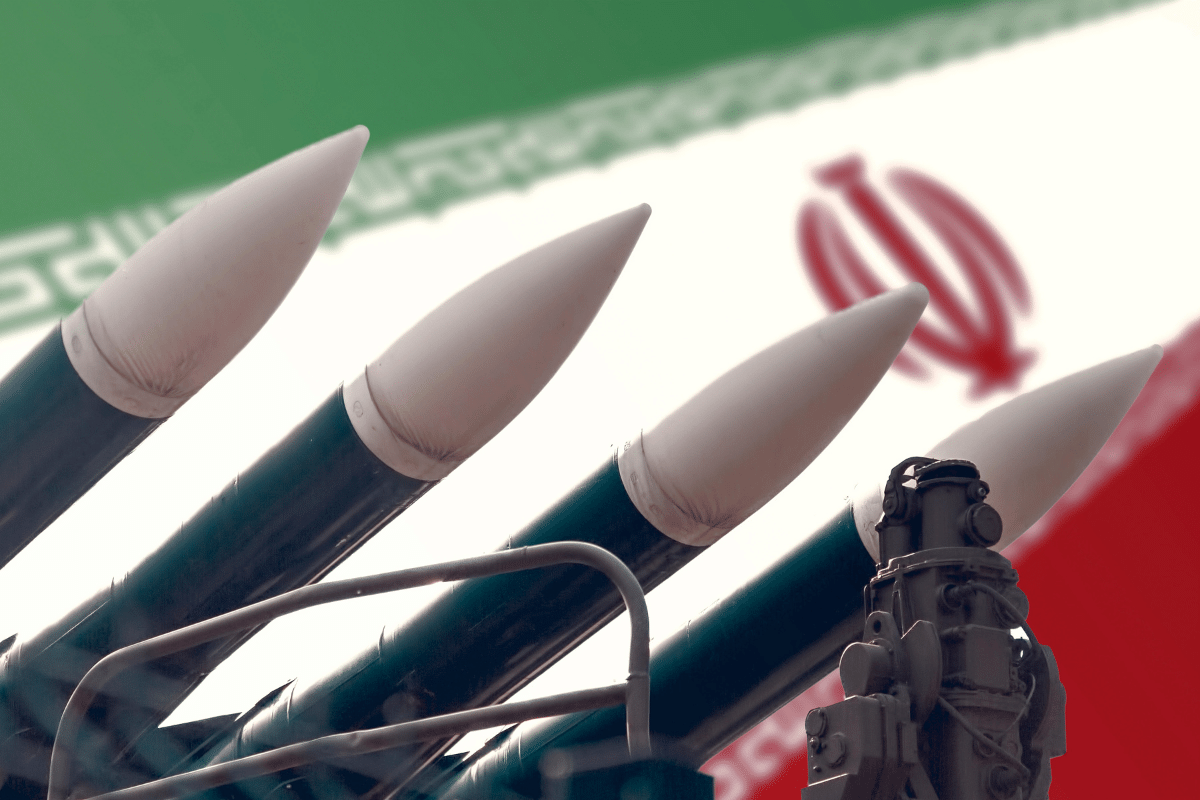Israel
From Gaza to Iran: New Fronts in Israel’s Ongoing War
The war that Hamas launched on 7 October 2023 has devolved into a regional conflict with wide and possibly calamitous international repercussions.

Vladimir Ilych Lenin reportedly once said that “there are decades in which nothing happens and there are weeks in which decades happen.” We are now in the midst of such weeks.
Over the past days, the war that the Gaza-based Palestinian terrorist organisation Hamas launched on 7 October 2023, when its fighters invaded southern Israel and massacred and raped 1,250 Israelis (and abducted another 250), has devolved into a regional war, something Washington feared and cautioned against for many months. In the days after the Hamas attack, Iran’s other regional proxies joined in, led by Hezbollah, Hamas’s much larger terrorist sister organisation, which rocketed Israel’s northern border settlements and military positions. Days later, the Iran-backed and -financed Houthi rebels in Yemen, 1,800 kilometres south of Israel, effectively closed the Bab al Mandab straits that connect the Indian Ocean to the Red Sea and Israel’s southern port city of Eilat, launching rocket and drone attacks against international shipping, and periodically at Israel itself.
And last week, on 1 October 2024, almost a year in, Iran showered Israel with 190 large ballistic missiles. Most landed in empty fields or were intercepted by Israel’s long-range Arrow (Hetz) and short-range Iron Dome (Kipat Barzel) anti-rocket missile systems, aided by American and British aircraft and missile systems. No Israelis were killed. But some of the missiles landed and lightly damaged two Israel Air Force (IAF) bases, and clusters of civilian buildings in the Tel Aviv area were also damaged, mostly by parts of intercepted rockets or their interceptors falling from the sky. Iran claimed it had targeted Israeli military and intelligence installations. (The only fatality was an Arab near Jericho in the West Bank.)
The massive Iranian attack has turned what began as a local war in and around the Gaza Strip and then expanded into a Hamas–Hezbollah–Houthi–Israeli war, has become a regional war with wide and possibly calamitous international repercussions.
Before the Iranians launched their attack, Washington warned Tehran to desist (“don’t,” in President Biden’s phrase), and Israel itself had reportedly cautioned the Iranians secretly that such an attack would trigger a devastating Israeli counterstrike. But a much-humiliated Iran went ahead, nonetheless.
Iran’s sense of humiliation was caused by Israel’s successes in the previous months of warfare, starting last July in Tehran, with Mossad’s provocative assassination of Hamas’s political leader Ismail Haniyeh, while he was a guest of the ayatollahs; and by September’s series of devastating attacks against Hezbollah, Iran’s chief proxy in the region. Those attacks began with the exploding pager and walkie-talkie operation of 17–18 September, which maimed some two thousand Hezbollah fighters, and culminated ten days later with the assassination of Hezbollah’s legendary leader Hassan Nasrallah, when eight IAF F-15s accurately dropped 83 one-tonne bombs targeting Hezbollah’s headquarters in an underground bunker in Beirut’s Dahiyah Quarter. The Israelis codenamed the operation “New Order” (Seder Hadash). In the lead-up to the Nasrallah assassination, the IAF, guided by precise intelligence, had killed most of Nasrallah’s chief military lieutenants in their “safe” apartments around Beirut. In the 27 September bomb attack on Nasrallah, General Abbas Nilforoushan, the deputy commander of the Iranian Revolutionary Guard Corps (IRGC), in charge of Iranian operations in Lebanon and Syria, died along with a dozen of the Hezbollah leader’s aides. The Israeli air assault two days later, on 29 September, on major Houthi economic installations—oil depots, port facilities, power plants—in and around the Yemeni city of Hodeida, in response to (failed) Houthi rocket attacks on Tel Aviv and Eilat, only deepened Tehran’s sense of abasement and impotence.

Following an apparently heated debate between the Iranian government’s moderate wing—led by the newly elected president, Masoud Pezeshkian—and the militant IRGC generals, backed by the country’s “Supreme Leader,” 85-year-old Ali Khamenei, the Iranians decided on revenge. The upshot was the massive Iranian rocket attack of 1 October. It was the second of its kind: last April, the Iranians launched a mix of 400 drones, cruise missiles, and more primitive ballistic rockets at Israel—in response, they claimed, to Israel’s aerial assassination of Nilforoushan’s predecessor, General Mohammed Reza Zhedi, the IRGC’s Quds Force commander in Lebanon and Syria, together with several of his aides, in the Iranian Embassy compound in Damascus. The Iranians claimed that this was a breach of international law and diplomatic immunity; Israel said that the man was aiding and abetting Hezbollah terrorism and was no diplomat.
Like the 1 October attack, the Iranian attack of 13–14 April was stymied by Israeli and American—as well as UK, French, and Jordanian—radar tracking, aircraft, and missiles, and did not kill any Israelis. But on that occasion, Israeli Premier Benjamin Netanyahu, curbing his generals, authorised only a symbolic Israeli response—a single-missile strike against a radar station deep in Iran. Netanyahu believed, or hoped, that Tehran would understand that, if Israel wanted to, it could hit important Iranian installations, including its nuclear project plants. But Tehran saw things differently. The muted Israeli response confirmed their assessment of Netanyahu as a hesitant, weak, and even cowardly leader who backed off when seriously challenged—and they could also point to Israel’s weak, ineffective response to Hezbollah’s daily rocketing of northern Israel’s border settlements over the previous months.
But this time around, Netanyahu and his generals have promised a robust Israeli counterstrike. Observers are talking about major Iranian economic installations or IRGC bases. There is also talk of Israel hitting Iran’s nuclear project, though Washington has told Israel that this is a no-no. The Iranians have announced that should Israel launch a major counterstrike, Iran will up the ante.
Jerusalem and Washington are currently discussing the prospective Israeli response. Israel is doubtless arguing that for decades Iran has been clobbering Israel through its proxies and, occasionally, directly (vide the Iranian-orchestrated destruction of Israel’s embassy in Buenos Aires and the demolition of the Jewish community centre in that city in the 1990s) and that it has recently speeded up its nuclear weapons project, which threatens Israel’s very existence, since Iran’s leaders—like those of Hamas and Hezbollah—have frequently declared that their aim is to destroy Israel. Moreover, Iran has repeatedly hit American bases and interests in the Middle East, and its nuclear project and terrorism jeopardise Washington’s Arab allies—Saudi Arabia, the United Arab Emirates, and Bahrain—as well as Israel. But the Biden Administration is fearful of being sucked into another Middle East war, after the recent “forever” wars in Iraq and Afghanistan—especially with a very iffy presidential election in prospect. The Americans are especially fearful of an Israeli assault on the Iranian nuclear installations and its oil facilities. A strike on the former would enrage Tehran; and an attack on the latter, would immediately hike world oil prices, hitting American consumers where it hurts—their pockets—on the eve of the elections.
The hubbub surrounding the Iranian rocket attack and the likely Israeli response has completely overshadowed another dramatic development: the IDF’s ground incursion into southern Lebanon, which began mere hours before the Iranian missile barrage. Israel apparently promised Washington that the incursions were not an “invasion” and would be chronologically limited and geographically insignificant. But Washington knows its history and the temptations of mission creep and still remembers Israel’s June 1982 invasion of Lebanon—which was announced as a limited, “40-kilometre”-deep, anti-PLO campaign but in which the IDF ended up occupying Beirut and strung out along the Beirut–Damascus highway, after battling the Syrian army in the Beqaa Valley. What followed was an eighteen-year Israeli occupation of parts of southern Lebanon challenged by an effective Hezbollah-led insurgency—a situation Israelis still remember as the “Lebanese quagmire.”

So far, the two Israeli divisions slowly pushing their way into southern Lebanon have been busy destroying Hezbollah units and infrastructure just north of the border—units and infrastructure designed for a ground invasion of the Galilee, similar to Hamas’s 7 October assault. Had Hamas synchronised its Nuhba Force assault that day with a similar assault by Hezbollah’s elite Radwan Force, Israel would have been in dire straits. But Hamas failed to coordinate with Hezbollah—or, for that matter, with Tehran—and Nasrallah decided to simply rocket northern Israel on a daily basis as a show of solidarity with Hamas and to pin down IDF units.
For ten months, Netanyahu and the IDF brass focused their offensive energies on Hamas. But by September 2024, Hamas had been militarily degraded—about half of its fighters have apparently been killed or maimed and almost all its weaponry destroyed—and local authorities in the Galilee, together with the 70,000 Israelis displaced from their homes for a year by Hezbollah rocketry, were demanding that the IDF facilitate their return home. Netanyahu at last unleashed September’s staggered offensive against Hezbollah, which began with the pager attack.
The IDF Intelligence Division and Mossad had clearly not wasted their time since the stalemated IDF invasion of southern Lebanon in 2006, which left Israel’s leaders, the IDF brass—and, in fact, most Israelis—with an exaggerated assessment of Hezbollah’s power, an overestimate that curtailed Israel’s responses to Hezbollah provocations and attacks right up until September 2024. By that time, Israeli intelligence had carefully studied Hezbollah’s deployments and had penetrated its command-and-control structures and personnel. This past month’s rapid decapitation of Hezbollah was the result.
It is unclear how far northward the two raiding or invading IDF divisions in southern Lebanon intend to advance, especially in view of the constraints imposed by Washington behind the scenes and the howls of outrage expected to come from much of the international community, as exemplified by UN Secretary General Antonio Guterres’s initial insipid response to the Iranian rocket attack on Israel—a response that prompted Israel, in an unprecedented move, to announce that it would ban Guterres from entering the country.
Israel has stated that its operation in southern Lebanon is designed to destroy “terrorist bases” and push back the Radwan force so that the “exiled” northern Israeli population, which feared a 7 October-style cross-border assault by Hezbollah, could return “in safety” to their homes. But this would, at a minimum, necessitate the Israeli “cleansing” and occupation of a strip of land 10 kilometres deep—the maximum range of Hezbollah’s very effective, fast, flat-trajectory anti-tank Kornet missiles, which have been used to devastate the Israeli border villages and military positions this past year. (Indeed, some of the evacuated settlements will require many months or years of repair to render them habitable again.)
But the problem is that all of Israel’s Galilee towns and villages would remain within range of Hezbollah’s rocketeers, who can hit them from thirty and fifty and seventy kilometres to the north as easily as from ten kilometres away and attack the advancing Israeli troops with Kornets and rockets as well. This is where the problem of mission creep comes in. As the past few days have shown, although badly battered, Hezbollah still has the will and ability to lob hundreds of rockets into northern Israel daily, with the occasional rocket even reaching the Tel Aviv area. So there is the prospect of a continuous Israel–Hezbollah war of attrition of the sort that Israelis don’t want and may ultimately be unable to sustain, with the Israeli troops advancing and the Hezbollah troops withdrawing, but with both the troops and the Israeli settlements in the Galilee, and points south still sustaining Kornet and rocket fire. The wars Israel has traditionally fought and won have been short wars: the week-long Israel–Egypt Sinai/Suez War of 1956; the Six-Day War of 1967; and the 19-day Yom Kippur or October War of 1973.
In its aerial campaign this September, the IDF may have destroyed some 50 percent of Hezbollah’s rockets (reputed before the war to number 150–200,000—though this may have been a Hezbollah- or Iranian-disseminated exaggeration). But everyone agrees that the organisation still has tens of thousands of rockets, some of which can reach Tel Aviv and Dimona, and most of its reputed 80,000 fighters are still alive and kicking and bent on revenge. Israel is currently busy sealing off Lebanon’s borders to prevent the arrival of new rocket shipments from Iran. In recent days, the IAF has bombed crossing points on the Lebanese–Syrian border and even forced aircraft from Iran to turn back before landing at Beirut’s Hariri International Airport (named after Rafic Hariri, the late Sunni prime minister murdered by the Nasrallah-led Hezbollah back in 2005). But this will not solve the immediate problem of Hezbollah rocketry. Some Israeli commentators have suggested that Israel needs to destroy Lebanon’s infrastructure—roads, international airport, power plants, etc.—to force the Lebanese population to compel Hezbollah to cease fire. And Israel may end up doing this—though, as in 2006, both Washington and Paris have been pressing Israel not to go down that road, which would alienate the international community and Lebanon’s non-Shi’ite populations.
A bleak reminder of the limits of Israeli power was provided last week when Moody’s and S&P lowered Israel’s credit rating, and offered prognoses of worse to come. Clearly, foreign investment has stopped and Israeli high-tech companies, the motor of the country’s economy, are in the doldrums. Israel is likely to request a massive financial bail-out from the Biden Administration—if it hasn’t already done so. And many of the IDF’s reserve troops, who account for some two-thirds of the army, have been on active service for months on end, away from their families and workplaces, battling Hamas in the south and now Hezbollah in the north, and many are becoming increasingly weary and disaffected. It appears that since the start of the war tens of thousands of young Israelis have left the country in the hope of leading less difficult lives in the West. And there is the continuing problem of Israeli casualties: some 1,660 Israelis have died since 7 October 2023. The war, together with the restrictions Israel has imposed on the Arab inhabitants of the West Bank and East Jerusalem, have triggered a rise in Palestinian terrorist attacks: seven Israelis were murdered by two Arabs from Hebron in Tel Aviv’s Jaffa suburb on the very day of the Iranian rocket assault. The IDF’s continued occupation of much of the Gaza Strip occasions periodic Israeli casualties; and the incursion into Lebanon has already cost the lives of nine IDF soldiers.
For Israel, the way forward seems to lie in an expansion of the war—in the north or south or both—until the country attains some sort of victory, or a diplomatic settlement is reached. A “victory” would mean forcing Hezbollah to cease fire in exchange, say, for a cessation of the IDF bombing campaign and withdrawal to the international border, or forcing Iran, after suffering real pain from IDF attacks, to cease its attacks and rein in its proxies: Hezbollah, Hamas, and the Houthis.
Both Hezbollah/Lebanon and Hamas have weighty reasons to seek an end to the conflict. Most of the Gaza Strip’s 2.3 million inhabitants have been displaced from their homes and are poorly fed and living in ramshackle tent “cities,” while much of the Strip’s original housing lies in ruins. A fifth of Lebanon’s six million inhabitants—most of them Shi’ites, Hezbollah’s people—have fled their homes in southern Lebanon, Beirut’s Dahiyah Quarter, and the Beqaa Valley, and Israel has instructed much of the area’s mostly Shi’ite population to evacuate as the IDF divisions push northwards. Many of the displaced people are either living in the street or in emptied schools or have crossed into Syria. Therein lies a measure of ambivalent hope.
A negotiated, diplomatic resolution of the conflict, or parts of the conflict, could involve Hamas’s release of the 100 or so Israeli hostages it still holds—half of whom may still be alive—in exchange for a complete IDF withdrawal from the Gaza Strip and the release of thousands of Hamas terrorists and fighters from Israeli prisons. The problem with this, from the Israeli perspective, is that no one—neither Americans, nor Emiratis, nor the Palestinian Authority—will replace the IDF deployment in the Strip and actually resist the remaining 20–30,000 Hamas fighters, which means that Hamas will likely regain control over the Strip and its population—who largely support them—and gradually rearm, leaving Israel and the inhabitants of its southern border in particular facing the prospect of another 7 October-style invasion in the future. A further problem is that the international community and the moderate Sunni Arab states—Jordan, Saudi Arabia, and the United Arab Emirates—link a settlement in Gaza to a two-state solution and the eventual emergence of a Palestinian state alongside Israel, something that is opposed by the Netanyahu government and by Iran, Hamas, and Hezbollah.
In the north, a negotiated settlement could be based on UN Security Council Resolution 1701 of 2006. That resolution called on the IDF to withdraw from southern Lebanon and required Hezbollah to withdraw to 30 kilometres northwards, away from the border, and to disarm. The UN force, UNIFIL, deployed in southern Lebanon, was supposed to assure Hezbollah’s compliance, with the assistance of the official Lebanese Army in the south. But Hezbollah failed to disarm—quite the opposite—and effectively brushed both forces aside and reasserted full control of the south down to the international frontier.
Lebanon’s Prime Minister Najib Mikati has recently stated that he supports the implementation of 1701 or a revamped 1701, and that the Lebanese Army would move into southern Lebanon. But this is pie in the sky. An IDF withdrawal from southern Lebanon and a cessation of IAF bombing would result in Hezbollah’s resurgence and its re-investment of southern Lebanon down to the border. Neither the Americans nor the French nor the UN nor the Lebanese Army—many of whose troops are Shi’ites who support Hezbollah—would fight them.
So we are back to square one. Meanwhile, the battle between the IDF and Hezbollah rages on and the Middle East—indeed, the whole world—is awaiting Israel’s response to the Iranian rocket assault.
CORRECTION: An earlier version of this essay misstated the month of Israel’s pager/walkie-talkie operation. Apologies for the error.






